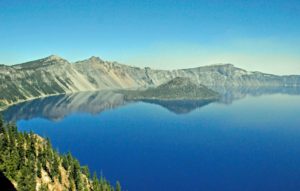
Crater Lake from the South Rim (Photo by Don Knebel)
For 400,000 years, volcanic eruptions in an area about 80 miles northeast of Medford, Oregon, created 12,000-foot-tall Mount Mazama. About 7700 years ago, the volcano erupted with a force more than 100 times greater than the 1980 eruption of Mount St. Helens, spewing out 3.5 billion cubic yards of molten rock. As continued flow emptied the magma chamber at the base of the mountain, the center portion of the mountain collapsed into the void, forming a caldera or crater more than 2000 feet deep and six miles across. Rain and snow then began filling the hardened lava crater. After about 250 years, the water escaping through evaporation and seepage equaled the amount coming in, stabilizing the resulting lake’s surface at 6178 feet above sea level, with an average depth of 1148 feet. Because no ground water enters the lake, its water is purer and clearer than that of any other lake on earth, allowing light to penetrate 144 feet, twice the distance of alpine lakes. The depth and clarity contribute to the vibrant blue color of what was originally called Deep Blue Lake and is now known as Crater Lake.
Archaeologists have determined that members of the Klamath tribe of Native Americans lived near Mount Mazama when the violent eruption created Crater Lake, which they came to regard as sacred. Seventy-five of their sagebrush sandals were found beneath volcanic ash in a nearby cave. Members of the tribe still repeat stories about the falling mountain, whose essential details match geologists’ explanation of how Crater Lake was formed.
Comments are closed.